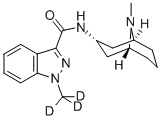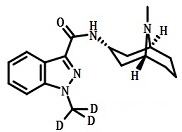Drug for chemotherapy-induced nausea and vomiting
Background
As one of the most important means of cancer treatment with positive effect, chemotherapy dose have many adverse reactions, among which vomiting is one of the most serious. The purpose of antiemetic therapy is to prevent or reduce the frequency and intensity of nausea and vomiting associated induced by chemotherapy. Early antiemetic drugs used in clinical practice have severe nerve center inhibition or extrapyramidal adverse reactions. Therefore, a variety of highly selective 5-ht3 receptor blockers have been developed since the 1980s and gradually develops into the mainstream drugs for the treatment of nausea and vomiting caused by chemotherapy. Based on the mechanism antiemetic drugs can be divided into dopamine blockers, vomiting central inhibitors, antihistamines, corticosteroids, 5-ht3 receptor blockers, and nk-1 receptor blockers.
5-HT3 receptor blocker
Since the launch of the first generation highly selective 5 - HT3 receptor blockers Ondansetron, a series of 5 - HT3 receptor blockers derivatives with determined curative effect and less adverse reaction have been used clinically, such as Granisetron, Navoban, Azasetron.
Mechanisms: the mechanism of chemotherapy induced nausea and vomiting is very complex which mainly includes the following aspects: the majority of cytotoxic drugs can stimulate the gastrointestinal mucosa causing mucosa damage and lead the chromaffin cells on mucous membrane, especially from the stomach to the ileal mucosa to release 5-HT which combines 5 - HT3 receptor to generate nerve impulses spreading to vomiting center forming vomiting; chemotherapeutic drugs and the metabolites stimulate and activate the vomiting center to form vomit; the various toxic substances in blood can act on the vomiting center unprotected by blood-brain barrier and the signal can be passed to vomiting center causing vomiting, the vomiting center reacts to a variety of stimuli which are activated through a series of receptors (dopamine receptors, histamine receptors, muscarine receptors, 5-HT3 receptors). Most antiemetic drugs also play a role in acting on one or more receptors. 5-HT is an important central transmitter in the human body. Its receptor is divided into 4 types,5-HT1, 5-HT2, 5-HT3, 5-HT4 and several subtypes. 5 - HT3 receptor blockers can be applied to the 5-HT3 receptors on vagus nerve to inhibit the excitement of vagal into fibers and inhibit the activation of AP and NTS 5 - HT3 by acting on the receptors, thus blocking afferent impulse to the vomiting center and inhibiting vomiting.
Nk-1 receptor blocker
Mechanism: P substance and its receptor are new targets for the treatment of nausea and vomiting drugs induced by chemotherapy. As a polypeptide containing 11 amino acids, Substance P along with neurokinin A (NKA) and neurokinin B (NKB) belongs to the tachykinin family which has three subtypes (NK 1 receptor, NK - 2 receptor, NK receptors - 3). P substance is mainly found in the central nervous system and gastrointestinal tract and has the strongest binding force with nk-1 receptor. There have been tests to prove that intravenous injection of P can cause vomiting, and the application of selective Nk-1 receptor blockers can block the vomiting caused by cytotoxic chemotherapy drugs.
Other Anti-nausea drugs
Aprepitant : usually in conjunction with other antiemetic drugs and can only be used to prevent nausea and vomiting caused by cancer drugs, noneffective for existing nausea and vomiting. Clinical studies show that NK- 1 receptor blockers aprepitant, along with 5-HT3 receptor blockers and dexamethasone, can increase the control ratio by 20% in acute vomiting, and by 30% ~ 40% in the delayed vomiting without drug tolerance in the later course of treatment.
The clinical trial phase Ⅲ of aprepitant show that on the basis of high dose of cisplatin, oral aprepitant (125 mg 1st day, 80 mg 2nd ~ 3rd day ) with
Ondansetron and Dexamethasone has better effect on acute and delayed vomiting than Ondansetron and Dexamethasone and good tolerance.
Casopitant: NK-1 receptor blocker developed by GlaxoSmithKline
According to the latest clinical data from casopitant(GW679769) for nausea and vomiting indications, casopitant has a better efficacy than ondansechin and matches arapitant if combined with ondansechin. The two dose phase Ⅱ clinical trials involving 1200 patients in the United States show that casopitant can be effectively used in moderate and severe vomint chemotherapy. In moderate vomit-induced chemotherapy trials, 85% of patients show completely curative effect with 150 mg casopitant used with dexamethasone and ondansechin , while the data is only 70% (P < 0.05) if dexamethasone and ondansechin are just used . In severe vomit-induced chemotherapy trials, 86% of patients have completely curative effect with 100mg casopitant and dexamethasone and ondansechin used, while the data is only 60%(P < 0.05) if dexamethasone and ondansechin are just used.





